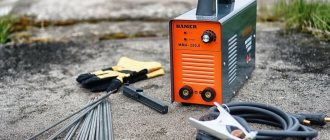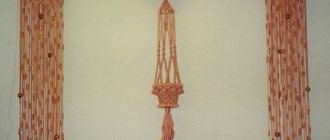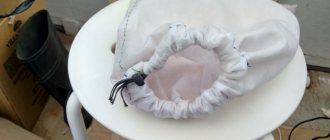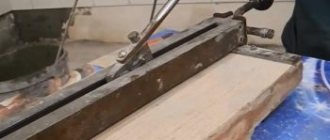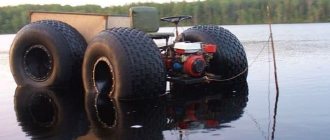An arched greenhouse is an indispensable assistant for any gardener, both experienced and beginner. It is this design that can be assembled quite quickly if you need to cover the garden bed during frosts. And it’s easy and simple to disassemble if necessary - you don’t have to make any special efforts. An arched structure (both factory-made and home-made) is assembled from arc-shaped elements, which you can make yourself if you wish. What types of greenhouse arcs are there, and what can you make them from with your own hands?
Arcs for greenhouse
Selecting a bend method
How to bend a pipe with your own hands? The question is not an easy one. When bending this product yourself, first of all, it is important to take into account the fact that during this process radial and tangential forces arise in the profiled metal, the impact of which can lead to rupture of the section and the appearance of folds on it.
To prevent this from happening, when forming a bend, it is necessary to take into account all the parameters of this process.
The technology that can be applied in each specific case is selected based on:
- Pipe material;
- Its size;
- Required bend angle and radius.
Having made a preliminary assessment of these parameters, you should choose one of the options proposed below. The photos below will help you understand the correct implementation of each of them, demonstrating step by step how to bend a pipe.
We assemble the greenhouse ourselves
And finally, we’ll tell you and show you one of the ways to make a greenhouse with your own hands very quickly and easily.
A simple greenhouse for a summer residence
To do this you will need:
- metal-plastic pipe, which is used to equip the heating system in the house;
- several meters of thick plastic film to cover the greenhouse;
- nylon twine;
- hacksaw for metal;
- wooden pegs or beads with a diameter slightly smaller than the pipe.
Prices for polyethylene film
polyethylene film
Step 1. Cut the metal-plastic pipe into equal lengths with a hacksaw. Their length will be equal to the length of the frame arcs.
Cutting metal-plastic pipe
Step 2. Bend the pieces into neat arcs.
Ready arches
Step 3. Saw the glazing bead into pieces approximately 25 cm long and sharpen on one side.
Ready-made glazing beads
Step 4. Insert bead pieces into the edges of the arches. The sharp end of the bead should point outward.
The bead is inserted into the arch
Step 5. Stick arcs in the garden in the place where you plan to install the greenhouse.
The finished arcs are stuck into the ground
Step 6: Stretch the twine between the arches along the sides of the arches.
Twine is stretched between the arches
Step 7. Make the central piece of twine that will run along the “ridge” part of the greenhouse longer, and tie the edges to pegs stuck in the ground. This will help, as it were, stretch the greenhouse and make it stable.
The central piece of twine must be firmly fixed
Step 8. Cover the greenhouse with film. It can be fixed around the perimeter of the greenhouse with boards, bricks, and stones.
The film around the perimeter is covered with earth
This kind of greenhouse can be made in literally 30-60 minutes of your time. Of course, this is not a permanent structure, but if weather forecasters have promised frosts, then this way you can quickly build a temporary greenhouse.
Heat
When exposed to high temperatures, many metals and their alloys become more ductile and less deformable. This rule applies to aluminum, duralumin, steel, copper, brass products and aluminum-ferrous bronze workpieces.
- When heating pipes made of tin bronze, gray cast iron or zinc alloys, you can get the exact opposite effect - they become more brittle when heated.
- It follows from this that not just any pipe can be heated for bending.
- It is possible to heat galvanized pipes, since their coating is not damaged in this case.
- When heating the product, you should not get too carried away, because under the influence of too high temperatures, oxygen begins to penetrate into the material, which entails its oxidation - an irreversible process that destroys the pipe. As an example, we can consider bending an aluminum billet.
- We heat the bending surface and bring a sheet of paper to it. If it lights up, the product can be bent.
As an indicator of the degree of heating of structures made of steel, their reddening to the state of scale can be used.
What should the arcs for a greenhouse be like?
Before we find out what material is ideal for making arcs for a greenhouse, let's talk about what an arched greenhouse is. This is a kind of tunnel, which is made from several arcs in a row stuck into the ground and covered with film or agrofibre. This structure is installed over a bed, which is usually heated not only by the sun, but also by the process of natural processing of biofuel placed under the ground. As a rule, this is a fairly lightweight structure and, if necessary, it can be moved to another, ordinary bed without any additional heating.
Film greenhouse
The function of a greenhouse is simple and understandable even to a novice gardener - this design allows you to retain heat around the plants and protect them during frosts. Also, a greenhouse is an excellent structure for hardening off seedlings in the spring, when it is already warm outside during the day, but at night it is cool for young plants.
Options for arched greenhouses made from arcs with covering material
A greenhouse can be installed on a foundation, but this is rarely done. In particular, it doesn’t even make sense to place an arched greenhouse on a foundation, since in this case it can’t be moved to another place so easily.
Arc greenhouses are often covered with spunbond
Now it’s time to talk about the arcs - arranged in one row, they will play the role of a greenhouse frame. It is with the help of arcs that the covering material will be held over the bed. We can say this is the main part of any greenhouse. Therefore, it is so important to be careful and careful when choosing arcs. Depending on the material from which they are made, these frame parts can have different quality. However, which of them is better is an open question, since often disadvantages in certain situations become advantages. So what should the arcs for a greenhouse be like? They must have the full properties described in the table below.
Arcs for greenhouse factory
Table. Basic properties of arcs for a greenhouse.
| Property | Characteristic |
| Strength | This is one of the main characteristics. The arches should, at a minimum, not break from simple touches, and even more so not crack and fall apart during rain or snow. Also, if you plan to periodically drag the greenhouse from place to place, the arcs should not crack at the ends. Unfortunately, this is often the case with industrial models, which sometimes cost a lot of money. Also, the arcs should easily withstand even wet covering material. |
| Ease of use | The arches should require as little attention and care as possible from the gardener, so as not to distract him from working in his garden. They must also be light enough so that even a person who does not have great physical strength can move them to another place and transport them, if necessary. |
| Good flexibility | Also quite an important factor for arcs. They should bend well, but at the same time keep their shape. |
| Ease | No one is safe from the fall of a greenhouse, and it may happen that the arcs collapse due to the wind, even if they are sufficiently well secured. If they are made of heavy material, when they fall they will damage all the plantings inside the greenhouse. A light one will break off at most a few leaves of plants. |
| Durability | It makes no sense to make more and more new greenhouses every year; it is much more convenient to use the same one for several years. Therefore, the material for the arcs must be strong and durable enough so as not to collapse in just a season or two of use. |
Greenhouse made of arcs, covered with agrofibre
It is worth noting that, based on all of the above, those arcs that combine all these properties as much as possible can be called high-quality. At the same time, convenient should be convenient, inexpensive and durable. If you decide to make greenhouse arcs yourself, then it is important to choose a material that will be fairly easy to process. Otherwise, you will spend too much time and effort to make even the simplest greenhouse. Let's take a closer look at the two main materials from which greenhouse arcs are made.
Arcs for greenhouse mini Agreen
Prices for arcs for a greenhouse
arcs for greenhouse
Filling with water or sand
Water is poured into the cavity of the workpiece, after which plugs are installed at both ends and cold is placed so that it freezes.
The product is bent by subsequently heating it with a gas burner. This method is not suitable for pipes that have a galvanized coating, as it can lead to damage.
The method using sand is applicable to pipes with a large cross-section or square configuration. Its essence lies in the preliminary filling of the workpiece cavity with sand. Then the pipe is thoroughly heated and bent by tapping it with a mallet. No heat is required to bend galvanized structures.
Decoration
Special importance is attached to the artistic design of the product; the area of manufacture or use can be determined by the style of painting.
Many styles of folk art are reflected in the decoration and design of the harness. Having seen a painted arc, a historian can easily tell the region of its use or manufacture.
Special importance was attached to the artistic design of the product. Gold and red painted arcs were especially valued. First, the wood is well primed and painted, then the decorating ornament is applied. Such artistic finishing is not only aesthetic, but also protects the wood from rotting and drying out. In addition to painted ornaments, the harness could be decorated with decorative carvings and embossed leather.
The bell and zga played a significant role. Zga is a small ring that is made at the bottom of the arch to secure the bell and lanyard from the bridle. Such a belt made it possible to support the head of a harnessed horse at a certain height. The bell was an integral attribute of Russian harness. Here, as they say, it should be “both seen and heard.”
Using Templates
This method is suitable for making complex pipe bends. The simplest template can be a piece of wire, pre-bent in accordance with how the product will be bent.
If it is possible to place the bent pipe section on a plane, self-tapping screws twisted into a piece of plywood can act as a kind of template. Bending is done gradually, checking the resulting result with the template from time to time.
Plastic arches
Greenhouses made on the basis of plastic arcs can be increasingly seen in gardening areas. The fact is that since plastic has firmly entered our lives, it is used almost everywhere. It is light, cheap, easy to process - what else is needed to build various structures from it with your own hands? That’s why greenhouses on plastic frames appeared at dachas.
Tunnel greenhouse with plastic arches
Plastic arches are good because they are not afraid of corrosion, which means they will withstand snow, heat, and torrential rain. This explains their durability.
Greenhouse with clips for arcs
Plastic is also very light, and a greenhouse made on the basis of such arcs can be easily assembled, carried and installed by anyone - even a child. True, plastic arcs are usually used only to create small structures.
Arches made of polyethylene pipes
One of the main disadvantages of plastic is some fragility. If you apply some effort, the material will crack and break. Although, again, everything is individual here - there is also such plastic that is not afraid of anything at all.
On a note! Arched plastic-based greenhouses can be purchased ready-made. They are usually inexpensive. The trouble with these greenhouses is that often their arcs crack at the bottom, which sticks into the ground.
How to make arcs for a plastic greenhouse? It's simple - there are two main ways. You will need a regular plastic plumbing pipe for water supply and a hair dryer.
Method No. 1
Step 1. Cut the pipe into required lengths.
Cutting plastic pipe
Step 2. While heating each piece of pipe in the middle, carefully bend it to the desired radius.
Heating with a hair dryer
Step 3. Along the perimeter of the bed where the greenhouse will be installed, insert metal or plastic pins in pairs opposite each other. The distance between each pair should be no more than 50 cm.
Plastic pin for fastening the greenhouse
Step 4: Simply slide the arcs onto the pins.
Step 5. At the top, connect the arcs with one straight pipe, securing it with clamps. She will not let the greenhouse collapse.
The arcs are connected by horizontal ties
Another option for attaching arches from pipes
Homemade fastener from an old hose
Method No. 2
It appeared when gardeners realized that the ideal frame for a greenhouse was a combination of metal and plastic. Here the frame installation system is almost the same, except that a metal rod, turned into an arc, is inserted inside each pipe. It looks like metal in a plastic wrapper. This will protect it from excess moisture.
To increase strength, metal rods are inserted inside the plastic arches
Application of rolls
This method is suitable for bending a metal profile. It is good because its use reduces friction on the surface of the product and reduces the risk of unwanted deformation.
As a result, much less effort has to be applied to obtain the desired bend, and damage to the part is minimized.
Using rolls, you can make your own pipe bender for bending pipes, allowing you to avoid the use of long parts. The three-roller version is most often used. Two rollers located in it play the role of outer supports, and the third one presses into the center of the fold.
This homemade device allows you to process round pipes, rectangular profiles, as well as plates and corners. Using it, you can bend the same radius over a fairly large length of the workpiece.
Other cladding materials
The greenhouse can be covered with any other covering material.
It can be film or non-woven material. They are cheaper than polycarbonate, but will also last much less. The only thing you can’t protect polycarbonate from is heavy hail. But here you need to rely on your desires and financial capabilities. For example, film will only last one season, no matter how strong it is, you will have to buy it and fix it every year. But it is easy to do.
Non-woven material is good because it perfectly allows air and moisture to pass through, and this is necessary for plants in especially hot summers. Depending on the density, the service life of such material is up to 5 years. It is removed for the winter and attached to the frame again at the beginning of the season.
Spring
The essence of this option is to place a spring of the required diameter, made of steel, into a bendable workpiece.
When bending, it holds the pipe, preventing it from being deformed incorrectly. The pre-profile element with a spring inserted into it is heated and then bent using pliers.
In certain cases, the spring can be replaced with a wire. Its bundle is installed in the pipe in separate pieces, and after the bend is completed, it is gradually pulled out.
Profile pipes
Profile pipes can have square, oval and rectangular configurations. It is quite difficult to bend them without violating the technical specifications. The most successful option for carrying out the work would be to use welding with preliminary filing of the walls of the workpiece with a grinder where the bend is planned.
Moreover, it would be advisable to first make cuts and bend the workpiece, and then weld the seams. If the part has a small diameter, then a regular soldering iron will do instead of welding.
Metal arcs
Previously, in our grandmothers' gardens, one could see arched greenhouses made precisely on the basis of arches made of durable metal. This material was not used in vain - it has a lot of positive properties that should form the basis of a good greenhouse.
Greenhouse diagram with metal arcs
- Metal is a durable material, especially if it is protected from corrosion by paint or galvanization. But since earlier the arcs were usually made from improvised material (for example, reinforcement), they, as a rule, were simply painted with ordinary paint and tinted as it peeled off.
- The arched metal structure turns out to be very durable - even if something falls on it, it is unlikely to collapse or fail (provided that the arches are well fixed in the ground).
- A greenhouse made of metal will last for decades if you treat it with care and change the coating in a timely manner.
- You can cover the metal frame with absolutely any material.
Greenhouses with a metal frame on the site
On a note! Metal arches are very strong, but heavy, and when installing a greenhouse with such a frame, make sure that they are well secured. Otherwise, during a strong wind, the greenhouse may collapse, and the heavy metal will damage and possibly destroy all your plantings.
The heaviness and difficulty of bending are the main disadvantages of metal arches. The second factor is the very reason why metal frames for greenhouses are usually purchased in stores and not made independently.
Construction of a greenhouse made of electric-welded steel arcs
You may need welding skills to make a greenhouse using metal arcs. As a rule, the arcs and the upper (ridge) metal crossbar are connected by welding. Sometimes the arcs are also connected at the bottom using two long metal parts. Then it turns out to be an almost indestructible (within reason, of course) monolithic structure.
Metal frame for greenhouse
Another disadvantage of metal arches is their price. Plastic is much cheaper.
How to make arcs for a metal greenhouse yourself? To do this, you will need a welding machine, metal pipes of the same diameter, and metal crosspieces.
Step 1. According to your idea, decide what length and what parameters each of the frame arcs should be.
Approximate diagram of a greenhouse on metal arcs
Step 2. Cut the arc into two equal pieces. Make such blanks in the required quantity (enough to cover the length of the greenhouse).
Cutting a pipe with a grinder
Step 3. Take a long horizontal pipe and weld tees (at the edges) and crosses to it at an equal distance from each other (approximately 40-50 cm).
Step 4. Take the previously prepared half-arcs and weld them to the crosses and tees so that you get a greenhouse frame. The final design will resemble a spine with ribs of some large animal. It is turned over and dug into the ground. All that remains is to cover the greenhouse with film.
Example of connecting half-arcs of a frame
On a note! It is not necessary to weld the greenhouse frame from metal pipes. You can simply bend them or even purchase metal reinforcing bars and bend them as well. It’s just that such a lightweight greenhouse will be less reliable.
An example of a simple miniature greenhouse on metal arcs
Metal-plastic pipes
They bend well by hand without requiring heating. The main thing is to ensure that the workpiece does not become excessively bent.
To perform the bend, you can also use wire by inserting it into the cavity of the metal-plastic pipe being bent, or connect heating to this procedure, while controlling the resulting temperature with a paper sheet.
Cladding material for greenhouse
Each greenhouse facing material has its own advantages and disadvantages. The simplest material is PVC greenhouse film, it is low cost, easy to install, and has minimal requirements for structures (wooden or metal base frame).
Disadvantages of greenhouse film:
- light mechanical damage;
- low level of thermal insulation;
Glass and film structures are gradually losing their popularity; they are being replaced by modern polycarbonate solutions.
Polycarbonate has many advantages: strength, attractive price, light transmittance and good thermal insulation. We are talking about cellular polycarbonate (plastic greenhouse), made in the form of two-layer briquettes.
The shelf life of this design is significantly higher than that of film. At a minimum, the greenhouse will last 10 years or more. Due to the heavy load, a wooden frame cannot be used here; you will have to construct a metal one to reliably hold the polycarbonate sheets.
Glass is considered to be the most durable and at the same time fragile cladding material. However, it holds heat well and transmits light well. Due to the serious requirements for the frame and structural reliability, glass loses to polycarbonate.
